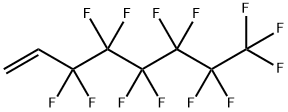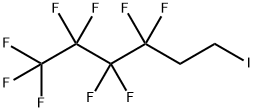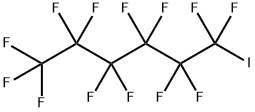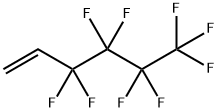(Perfluorohexyl)ethylene
- CAS NO.:25291-17-2
- Empirical Formula: C8H3F13
- Molecular Weight: 346.09
- MDL number: MFCD00039249
- EINECS: 246-791-8
- SAFETY DATA SHEET (SDS)
- Update Date: 2025-04-09 17:45:08

What is (Perfluorohexyl)ethylene?
Chemical properties
clear colorless liquid
Flammability and Explosibility
Not classified
Properties of (Perfluorohexyl)ethylene
| Boiling point: | 102-104 °C(lit.) |
| Density | 1.52 g/mL at 25 °C(lit.) |
| vapor pressure | 46.4hPa at 25℃ |
| refractive index | n |
| Flash point: | 68 °F |
| storage temp. | Flammables area |
| solubility | Chlorform (Slightly), Methanol (Slightly) |
| form | Liquid |
| color | Clear colorless |
| Specific Gravity | 1.520 |
| Water Solubility | 1.21mg/L at 25℃ |
| BRN | 2060994 |
| CAS DataBase Reference | 25291-17-2(CAS DataBase Reference) |
| NIST Chemistry Reference | 1h,1h,2h-Perfluoro-1-octene(25291-17-2) |
| EPA Substance Registry System | 1-Octene, 3,3,4,4,5,5,6,6,7,7,8,8,8-tridecafluoro- (25291-17-2) |
Safety information for (Perfluorohexyl)ethylene
| Signal word | Danger |
| Pictogram(s) |
 Flame Flammables GHS02  Exclamation Mark Irritant GHS07 |
| GHS Hazard Statements |
H225:Flammable liquids H315:Skin corrosion/irritation H319:Serious eye damage/eye irritation H335:Specific target organ toxicity, single exposure;Respiratory tract irritation |
| Precautionary Statement Codes |
P210:Keep away from heat/sparks/open flames/hot surfaces. — No smoking. P261:Avoid breathing dust/fume/gas/mist/vapours/spray. P305+P351+P338:IF IN EYES: Rinse cautiously with water for several minutes. Remove contact lenses, if present and easy to do. Continuerinsing. |
Computed Descriptors for (Perfluorohexyl)ethylene
New Products
4,4-Difluoropiperidine hydrochloride tert-butyl 9-methoxy-3-azaspiro[5.5]undecane-3-carboxylate Indole Methyl Resin N-Isopropylurea N,N-Dicyclohexylcarbodiimide(DCC) MELDRUMS ACID 5-METHYLISOXAZOLE-4-CARBOXYLIC ACID Magnessium Bis glycinate Zinc ascorbate 1-bromo-2-butyne 2-acetamidophenol 9(10H)-anthracenone Erythrosin B, 4-Piperidinopiperidine 2-((4-morpholinophenylamino) (methylthio) methylene) malononitrile 2,4-dihydroxybenzaldehyde 3-(4-morpholinophenylamino)-5-amino-1H-pyrazole-4-carbonitrile Methyl 2-methylquinoline-6-carboxylate 2,6-dichloro-4-nitropyridine 4-Bromo-2-chlorobenzonitrile 2-(benzylamino)acetic acid hydrochloride 4-(tert-Butoxycarbonylamino)but- 2-ynoic acid 3,4-dihydro-2H-benzo[b][1,4]dioxepine 1-Phenyl-1-cycloprppanecarboxylicacidRelated products of tetrahydrofuran








You may like
-
 (Perfluorohexyl)ethylene CAS 25291-17-2View Details
(Perfluorohexyl)ethylene CAS 25291-17-2View Details
25291-17-2 -
 3-(4-amino-1-oxoisoindolin-2-yl)-1-methylpiperidine-2,6-dione 98%View Details
3-(4-amino-1-oxoisoindolin-2-yl)-1-methylpiperidine-2,6-dione 98%View Details -
 614-19-7 98%View Details
614-19-7 98%View Details
614-19-7 -
 3112-85-4 Methyl phenyl sulfone 98%View Details
3112-85-4 Methyl phenyl sulfone 98%View Details
3112-85-4 -
 20677-73-0 (2,2-diethoxyethyl)methylamine 98%View Details
20677-73-0 (2,2-diethoxyethyl)methylamine 98%View Details
20677-73-0 -
 3-(4-(hydroxyamino)-1-oxoisoindolin-2-yl)piperidine-2,6-dione 98%View Details
3-(4-(hydroxyamino)-1-oxoisoindolin-2-yl)piperidine-2,6-dione 98%View Details -
 57381-49-4 2-bromo-4-chlorobenzonitrile 98%View Details
57381-49-4 2-bromo-4-chlorobenzonitrile 98%View Details
57381-49-4 -
 4,6-dichloropyrimidine-5-carbaldehyde 98%View Details
4,6-dichloropyrimidine-5-carbaldehyde 98%View Details
5305-40-8
Statement: All products displayed on this website are only used for non medical purposes such as industrial applications or scientific research, and cannot be used for clinical diagnosis or treatment of humans or animals. They are not medicinal or edible.
